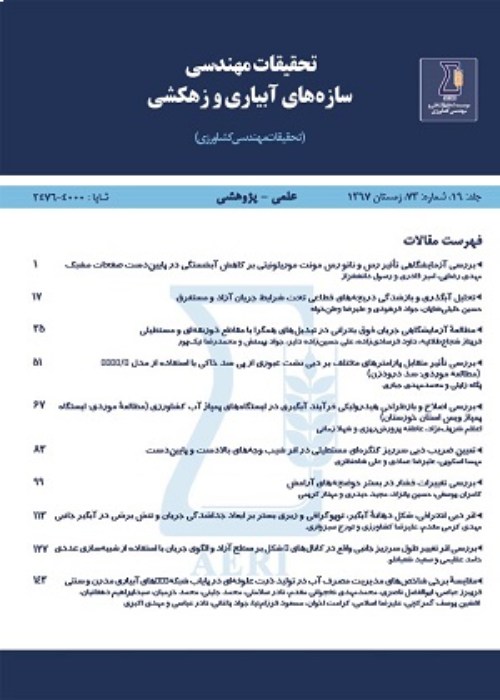Investigating the volume of irrigation water and applied water productivity in barley fields of Razavi Khorasan province (Sabzevar and Neyshabur)
Water management in the agricultural sector is very important as the largest consumer of water resources in the country. Estimation or determination of water use management indicators, including the amount of water consumed, irrigation efficiency and water productivity of various agricultural and horticultural crops in the country, is one of the most important key indicators in macro-planning related to supply of water, allocation and consumption in different sectors including agriculture. The volume of water used by agricultural crops as one of the indicators for evaluating the optimal use of water resources and plays a very important role in the management and macro-planning in the field of water management and engineering. Barley plant is cultivated and produced in almost all the countries of the world and it is considered as the fourth grain in the world in terms of production after wheat, corn and rice. In Iran, barley with a cultivated area (irrigated and rainfed) of more than 1,684,000 hectares and with a production of more than 3,176,000 tons, after wheat, it is the most important crop and is cultivated in most parts of the country due to its wide ecological compatibility. Due to the economic importance of barley production in the country, it is necessary to study the volume of irrigation water and water productivity to produce this strategic product.
In Khorasan Razavi province, 2 cities with the highest area under barley cultivation were selected for evaluation, Sabzevar and Neyshabur. To conduct this research, 12 fields in Sabzevar region and 12 other fields in Neyshabur region have been selected. The volume of irrigation water was measured in these 24 fields during the irrigation season. The measurements were carried out in different irrigation and planting methods, various soils, different salinity of irrigation water and soil and different barley varieties during the growing season of 2021-2022 without interfering with the farmer's irrigation management. The measured values were compared with the gross irrigation water requirement estimated by the Penman-Monteith method using the last 10 years meteorological data and also with the national water document values. Crop yield was recorded at the end of the growing season and water productivity was calucated as the ratio of yield to total water (irrigation applied water and effective rainfall).
The results showed that the amount of applied water, the amount of barley yield and the water productivity in Sabzevar region were 4710 m3/ha, 2.86 ton/ha and 0.77 kg/m3, respectively. The amount of applied water, the amount of barley yield and the water productivity in Neyshabur region were determined as 4408 m3/ha, 2.54 ton/ha and 0.61 kg/m3, respectively. The volume of barley irrigation water in the studied areas varied from 2393 to 7911 and its weighted average (based on the cultivation area) was 4593 m3/ha. While the average gross requirement of irrigation water in the studied areas using the Penman-Mantis method using meteorological data of the last ten years and the national water document was 9111 and 8489 m3/ha, respectively. The average yield of barley in the selected fields varied from 1600 to 5600 and its weighted average was 2310 kg/ha. Irrigation water productivity in the selected farms varied from 0.24 to 2.34 and its weighted average was determined to be 0.58 kg/m3. The applied water productivity in the selected farms varied from 0.21 to 1.57 and its weighted average was determined as 0.45 kg/m3.
According to the results of this research, in the two regions of Sabzevar and Neyshabur, the weighted average (based on the area under barley cultivation in the two regions) of the volume of irrigation water and the irrigation water productivity in barley fields are 4593 m3/ha and 0.58 kg/m3, respectively. It was obtained. The amount of irrigation water in the production of barley in these two regions is about 5.8% less than the national average and the applied water productivity is about 35.6% less than the national average. The calculated gross irrigation requirement was obtained by using the national water document and the book "Estimation of water requirement of agricultural and horticultural plants of the country", respectively 9111.3, 8489 and 8566 m3/ha. In terms of the share of effective rainfall in irrigation water, the results showed that 37 and 27% of the amount of irrigation water was supplied through effective rainfall in Neyshabur and Sabzevar, respectively. By comparing the amount of irrigation water used by farmers in the barley fields with the gross irrigation requirement, the result was that the farmers did not have enough water for irrigation and Unintentionally, they have done deficit irrigation in the barley fields, and in fact, the farmers have done irrigation as much as they had water.
- حق عضویت دریافتی صرف حمایت از نشریات عضو و نگهداری، تکمیل و توسعه مگیران میشود.
- پرداخت حق اشتراک و دانلود مقالات اجازه بازنشر آن در سایر رسانههای چاپی و دیجیتال را به کاربر نمیدهد.


